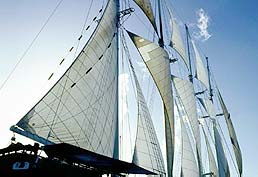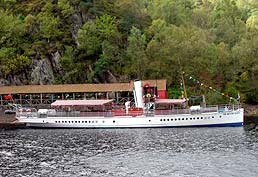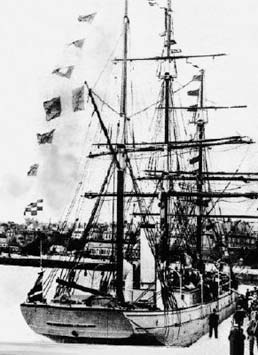|
|
|||||||||||||||||||||||||||||||||||||||||||||||||||||||||||||||
 |
|
||||||||||||||||||||||||||||||||||||||||||||||||||||||||||||||
| In
comparison with the era of sailing ships, steam sailing vessels
were used The first low pressure steam-drive was invented in 1765 by the Scottish engineer James Watt (1736–1812). Fact is, that Heron of Alexandria (around 60 AD) invented an early version of the steam turbine, but his “steamball”, named “Aeolopile”, served more as an amusement for the observer than any real mechanical purpose. Generally the invention of the steamboat has been accredited to the American Robert Fulton. On his first trip on 7th August 1807, he actually made the journey up the Hudson River, from New York to Albany without the use of sails. His “Clemont” needed a full 32-hours to complete the 150-mile trip. Only a few weeks later, on 4th September, passengers started paying a fare, to be the first to experience a trip on Fultons “North River Steam Boat”. Successful experiments with machine-driven ships had been carried out, before Fulton commercialised steam navigation. For example, the Frenchman Marquis de Jouffroy d’Addan, sailed down the Saône near Lyon, as early as 1776 using steam-drive. Names like James Rumsay, Samuel Morey or Robert Stevens should also be mentioned here. The British are more likely to consider William Symington to be
the true inventor of steam navigation. In March 1803 he built the
“Charlotte Dundas”, the first general-purpose steamboat
but he was not able to undertake further development for the purpose
of commercial usage in his lifetime. Credit will probably still
go to Robert Fulton as the inventor of the steamboat. The advantages of steam navigation compared to the usage of wind power are obvious: With conventional sailing methods you had to rely on favourable weather, whereas the steam machine enable navigation independent from the weather conditions, which the sailors had no way of influencing. It is understandable that the new technique quickly found a place in shipping. In the beginning of the 19th century, the construction of steam-powered vessels gained in importance. The “Savannah” was the first steam-powered vessel to cross and recross the Atlantic Ocean in 1819. After a five year building period, the “SS Great Britain”, constructed by Isambard K. Brunel, was launched in 1843. She was the “mother of all modern ships” and with a length of 98 metres, she was not only the largest but also the first iron hulled screw propeller-driven, steam-powered passenger liner to cross the Atlantic Ocean at the time. You can still visit this impressive sixmasted ship today. In 1970 the “SS Great Britain” was towed from the Falkland Islands back to her home harbour of Bristol, where she was lovingly restored and can now be admired as a symbol of Victorian splendour. The “Great Eastern”, the biggest ship of her day, was launched in London in 1857. In 1866 the crew of this iron monster started a very special undertaking: the laying of the first transatlantic cable. Other famous steam-powered vessels were the “Carnatic”
(90 metres long; on 13th September 1869 she ran aground
on a Coral Reef in the Red Sea), the “Dunraven” (a merchant
ship, which also sank in the Red Sea in March 1876), the “USS Alabama”
(an American steamer built in 1890) and the “Pourquoi Pas ?”,
manufactured in 1908. The whaler mentioned in “Jónas Blondal”, the “Eiríkur Rauði”, is a threemasted steam bark. At the end of the 19th century steamers of this kind were often used for whaling (please note about whaling › about the history of whaling › The Hunt for Doeglings). The advantage of the rigging, typical for barks, was that the operation of the mizzen mast was a lot easier. This allowed more men to take part in the hunting and processing of the whales. In the year 982, the Viking explorer “Eric the Red” discovered Greenland. “Eiríkur Rauði” is the Icelandic version of his name. The penultimate letter, the “eth”, is pronounced “th”, like in “father”. To ensure a realistic portrayal of the whaler in the drawings, a model of the “Pourquoi Pas ?” was used to draw the “Eiríkur Rauði”. The original “Pourquoi Pas ?”, completed 1908 in Saint-Malo, had a very eventful history. Built as a research vessel, the threemaster was at the disposal of the Doctor and Commander Jean-Baptiste Charcot (1867–1936) for 28 years. The tragedy happened during the last expedition in the waters of Greenland: On 16th September 1936 the “Pourquoi Pas ?” hit a submerged rock off Bargafjord, 30 sea miles from the Icelandic seaport of Reykjavík. Charcot and 42 of his crew were drowned. There was only one survivor. Photos (from the top): Jens F. Ehrenreich (illustration); IMSI Masterphotos, USA; mcleod/sxc; Pourquoi Pas ? by kind permission of Olivier Thomas, France |
|
||||||||||||||||||||||||||||||||||||||||||||||||||||||||||||||



